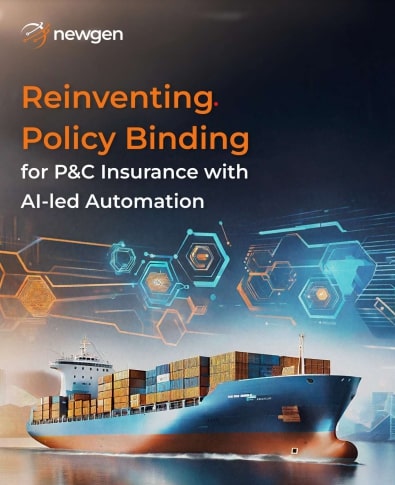Making Policy Generation Faster, Intelligent, and More Compliant with AI Automation
Policy binding is one of the most critical functions in the property and casualty insurance lifecycle. It is the moment when insurers formally commit to coverage, pricing, and legal accountability. Yet, it is also one of the most complex and manual activities in many P&C organizations. From clause-level customizations to compliance validation and multi-region regulation mapping, the process can easily become slow, expensive, and vulnerable to errors that expose insurers to risk.
This whitepaper explains why the policy binding function must evolve and how AI-led automation can reduce operational burden, improve regulatory alignment, and elevate the overall experience for underwriters, brokers, and customers.
Why Policy Binding Needs a Rethink?
P&C insurance has traditionally lagged behind other industries in digital modernization. Policy binding still relies heavily on manual tasks including document drafting, template updates, and compliance checks. These outdated methods not only slow down underwriting responsiveness but also create inconsistencies that become costly to correct later.
Common challenges include:
- Excessive document handling and version control issues
- Template variations that multiply without standard governance
- Limited visibility into clause-level compliance or risk exposure
- High administrative effort from underwriters and product teams
- Delayed issuance causing dissatisfaction or lost business
This complexity becomes more difficult to manage as products grow in sophistication and customers expect quicker turnaround.
Where Inefficiencies Occur Most?
The whitepaper identifies four major sources of policy binding delays and operational strain:
- Manual Policy Creation and Customization
Underwriters frequently edit policies clause by clause to meet unique coverage requirements. This makes document generation slow and error-prone and increases the likelihood of oversight.
- Difficulty Tracking Template Versions
Each jurisdiction or product line requires its own wordings. Without real-time tracking and centralized management, teams lose visibility into what is current and what is outdated.
- Inconsistent Templates and Limited Audit Trails
When teams rely on personal knowledge rather than standardized libraries, inconsistencies emerge. Missing audit trails make regulatory reviews harder and expose insurers to legal risk.
- Duplication of Templates
Carriers often accumulate hundreds of similar templates due to regional variations. This makes governance more complicated and slows down updates dramatically.
These operational pain points affect more than productivity. They limit growth potential and increase enterprise risk.
What Modern Policy Binding Should Deliver?
Insurance carriers gain efficiency and consistency when policy binding becomes an intelligent, digital-first workflow. The whitepaper highlights a future state model built on:
- Smart clause libraries aligned with standardized terminology
- Dynamic templates that adjust coverage based on rules
- AI-supported customization for unique risks
- Automated version tracking for governance control
- Real-time collaboration among underwriting and distribution teams
- Complete traceability of decisions, changes, and approvals
This shift transforms policy binding from a reactive process to a strategic advantage.
How AI and Automation Solve Policy Binding Challenges?
AI-powered decision support improves every stage of policy creation. Key advancements include:
- Automated Clause Management
Intelligent systems recommend clause selections based on risk profiles, jurisdictional rules, and policy type. Standardization improves accuracy and reduces manual review. - Generative AI for New Wording
Where existing clauses fail to meet unique coverage needs, GenAI can propose new text aligned with approved language styles and compliance requirements. - Dynamic Document Generation
Templates evolve automatically as risk details change, eliminating unnecessary drafts and rework. This supports faster bind outcomes for both routine and large cases. - Intelligent Compliance Monitoring
Regulatory requirements shift often. AI continuously checks template and clause alignment, preventing outdated rules from influencing bound contracts. - Consolidated Repository for Risk and Audit Readiness
Every modification, approval, and clause update is tracked, protecting the carrier during reviews and disputes.
With automation, policy binding becomes faster, smarter, and significantly more defensible.
Why User Experience Matters?
Policy binding involves multiple stakeholders who each expect improved clarity and speed. Insurers must ensure:
- Underwriters can work within intuitive digital tools
- Brokers receive clear and timely communication during binding
- Customers get faster confirmations for requested coverage
- Risk and compliance teams gain transparency without delays
Better experiences build confidence and competitive edge in a crowded market.
A Scalable Framework for Transformation
The whitepaper recommends an incremental strategy for P&C organizations modernizing policy binding:
- Identify templates with highest manual workload or risk exposure
- Consolidate and standardize clause libraries
- Introduce dynamic rules for faster customization
- Automate compliance checks and tracking
- Enable AI-driven insights for quality and consistency
- Expand automation across more lines and geographies
This phased approach reduces risk and ensures value is realized quickly.
Business Benefits within Reach
With transformation, carriers can expect:
- Reduced turnaround time for policy issuance
- Lower cost of underwriting operations
- Improved compliance accuracy
- Higher productivity of underwriting teams
- Better policy consistency and customer trust
This modernization directly influences time-to-bind performance and portfolio profitability.
How Newgen Enables Policy Binding Reinvention?
Newgen supports P&C insurers with a unified digital transformation platform that integrates workflow automation, content intelligence, and clause standardization into the policy lifecycle. The platform strengthens governance and speeds execution from policy creation through binding, helping underwriters keep pace with demand while maintaining quality and transparency. Insurers operate with improved agility and resilience in a dynamic regulatory environment.
Advancing Policy Binding for the Future
As P&C risks grow more complex and customer expectations accelerate, insurers need smarter and more efficient policy binding operations. Digital adoption in this area unlocks faster growth, reduces operational risk, and enhances collaboration across the underwriting ecosystem. By investing in intelligence-led modernization today, carriers can build the strong and adaptable policy processes needed to compete in a digital-first insurance market.

